Occupational environment monitoring of a candy manufacturing factory
99,000 ₫
Note: The above price is calculated for one sample, and the price may fluctuate depending on the area of the environment to be monitored and market movements. For more accurate pricing support, please refer to the price list or contact our consulting staff directly.
Monitoring the environment of a candy manufacturing factory is a session of collecting, analyzing, and evaluating factors at the workplace that may harm workers health.
Table of Contents
Toggle1. Overview of Candy Manufacturing Factory
a. What is a candy manufacturing factory?
Factory producing candy is a large-scale production facility specialized in manufacturing and packaging various types of candy. Candy manufacturing factories are typically designed to accommodate production lines, equipment, and machinery for performing the candy production processes.
The machinery and equipment used in candy factories include measuring machines, candy cookers, mixers, molding machines, presses, surface decoration machines, and packaging and boxing equipment.
Candy factories can produce a wide range of candies, including chewing gum, gummy candy, hard candy, cotton candy, and many other types depending on market demand and customer requirements.

b. Production processes in a candy manufacturing factory
The production processes in a candy manufacturing factory include:
- Ingredient preparation: Necessary ingredients for candy production include sugar, water, starch, sweeteners, pH adjusters, flavorings, and food coloring. Candy factories must ensure proper storage and handling of ingredients to maintain product quality.
- Mixing and cooking: Ingredients are mixed together and then cooked to form the candy mixture.
- Molding and refining candy: The candy mixture is put into molding machines to achieve the desired shapes and sizes. Then, candy is refined using presses or surface decoration with fine sugar.
- Flavoring and coloring: Some candies may be enhanced with flavorings and colors to achieve different tastes and appearances.
- Candy packaging: Candy is packaged in sealed bags or boxes to ensure hygiene and preservation until consumption.

c. Types of machinery used in candy factories
The types of machinery commonly used in candy factories include:
- Measuring machines: Used to measure the required ingredients for candy production.
- Mixers: Used to mix ingredients into a uniform candy mixture.
- Candy cookers: The mixture is cooked and solidified in candy cookers.
- Molding machines: Used to shape the candy into desired forms and sizes.
- Presses: Used to refine candy texture.
- Surface decoration machines: Used to decorate candy surfaces with fine sugar, flavorings, and colors.
- Packaging and boxing equipment: Specialized machines to package and box candy to ensure hygiene and preservation until consumption.
Different types of candies may require different machinery and equipment for production.

d. Occupational diseases in candy manufacturing workers
Food manufacturing industries such as candy production may pose safety and health risks to workers. Some occupational diseases that may occur in candy factories include:
- Respiratory diseases: Dust from ingredients or chemicals may cause respiratory issues, such as pneumonia or asthma.
- Skin diseases: Chemicals in candy production may dry or irritate the skin, causing conditions like allergic dermatitis or contact dermatitis.
- Musculoskeletal disorders: Activities such as lifting, pulling, and pushing during candy production may lead to musculoskeletal injuries and back pain.
- Vision-related issues: Tasks requiring prolonged focus on lights or electronic devices may cause eye strain, headaches, and vision-related problems.
To minimize these occupational risks, candy factories should implement workplace safety measures, provide full protective equipment to workers, and train and raise awareness about occupational health and safety.

e. Common types of candy on the market
There are many popular types of candy on the market, each with its own characteristics and flavors. Some common candies include:
- Chewing gum: Made from gum base, available in flavors such as strawberry, mint, orange, etc.
- Caramel candy: Made from sugar, cream, and butter, with the distinctive caramel aroma.
- Chocolate: Made from chocolate, available in varieties such as dark chocolate, white chocolate, milk chocolate, etc.
- Gummy candy: Soft and chewy candies, available in different colors and flavors.
- Lollipops: Lightweight and soft candies made from sugar and fats, available in various colors and flavors.
- Chewable candy: Made from sugar and artificial flavorings, with high chewiness.
- Fruit candy: Made from fresh or dried fruits, retaining natural fruit flavors and colors.
- Sesame candy: Made from roasted sesame, sugar, and flavorings, with a distinctive sesame aroma.

2. Overview of Workplace Environment Monitoring Service
a. What is workplace environment monitoring in candy factories?
Workplace environment monitoring (or occupational environment measurement) in candy factories involves collecting, assessing, and analyzing measured indicators of workplace environmental factors in candy factories to implement timely measures, reduce environmental impact on workers’ health, and prevent occupational diseases. Workplace environment monitoring is mandatory for candy factories.
Monitoring plays a crucial role in caring for, protecting, and improving workers’ health because the main workforce of a company directly generates its profits. Workers frequently exposed to hazards exceeding permissible limits are at risk of health issues and occupational diseases.
REGISTER FOR WORKPLACE ENVIRONMENT MONITORING SERVICE
b. Nam Viet’s workplace environment monitoring program
Nam Viet’s workplace environment monitoring program is developed by monitoring engineers specializing in occupational safety and environmental protection. Aimed at ensuring workers’ health and safety, the program uses modern measurement methods to monitor air quality, water, microclimate, physical factors, dust, and other elements in the workplace. This program is essential for maintaining a safe working environment and protecting workers’ health.
Additionally, Nam Viet’s monitoring program contributes to research and development of new solutions to improve workplace environmental quality. With the dedication and professionalism of monitoring experts, Nam Viet’s exclusive program is a breakthrough in occupational safety management and environmental protection in Vietnam.

c. Standardization in workplace environment measurement procedures
Standardization in Nam Viet’s workplace environment measurement procedures is crucial for ensuring measurement quality. To ensure accuracy and reliability, the program follows recognized standards and standardized procedures from Ho Chi Minh City Department of Health. This ensures that collected data is highly reliable for evaluating the workplace environment and making informed decisions to improve it for workers’ health.
These standardized procedures also ensure that measurements are conducted by highly qualified monitoring specialists with years of experience, allowing managers and experts to trust results from An Toan Nam Viet and make accurate, valuable decisions for protecting workers’ health and the environment.
By applying standardized procedures, Nam Viet demonstrates its commitment to providing a safe working environment and protecting workers’ health, while also contributing to the improvement of occupational safety and environmental management quality in Vietnam.
d. Reporting results of candy factory monitoring
Workplace environment monitoring results are prepared according to Form No. 04, Appendix III issued with Decree 44/2016/ND-CP and prepared in two copies: one copy sent to the workplace that signed the monitoring contract, and one copy kept by the monitoring organization.
The retention period for workplace environment monitoring results is indefinite as per legal regulations.

e. Frequency of workplace environment monitoring according to the law
According to Clause 2, Article 18 of the Law on Occupational Safety and Hygiene 84/2015/QH13, employers must organize workplace environment monitoring to assess harmful factors at least once a year.
f. Deadline for submitting workplace monitoring reports according to the law
The report submission deadline is before December 31 each year. Enterprises in production facilities must submit workplace monitoring reports to the local Department of Health at the location of their headquarters and where employees work.
When there are changes in technology, production processes, or upgrades/renovations of the workplace that may introduce new harmful factors, enterprises must update occupational hygiene records to include relevant monitoring content.
g. Regulations on penalties for employers violating workplace environment monitoring requirements
According to Article 27 of Decree No. 12/2022/ND-CP dated January 17, 2022, regulating administrative penalties in labor, social insurance, and Vietnamese workers working abroad under contracts:
- Clause 2: Fines of VND 2,000,000 – 5,000,000 for employers who fail to publicly inform employees at the workplace monitoring site and areas managed of hazards immediately after receiving monitoring results and hazard assessment results.
- Clause 3: Fines of VND 20,000,000 – 40,000,000 for employers who do not conduct workplace environment monitoring to control harmful effects on employees’ health as required by law.
- Clause 4: Fines of VND 40,000,000 – 60,000,000 for employers who collude with monitoring organizations to commit fraud in workplace monitoring activities without reaching criminal liability.
3. Harmful Environmental Factors for Workers in Candy Manufacturing Factories
There are many environmental factors that can be harmful to workers in candy manufacturing factories, including:
- Dust and fumes: During production, the use of machinery and equipment can generate dust and fumes, causing discomfort and affecting workers’ health.
- Chemicals: Workers often come into contact with chemicals such as colorants, flavorings, preservatives, sweeteners, and gelling agents. If protective equipment is not properly worn or chemicals are misused, they can be harmful to health.
- Temperature and humidity: Candy production requires specific temperature and humidity conditions. Improper control can negatively impact workers’ health.
- Noise: Operating machinery during candy production can generate noise, affecting workers’ hearing.
- Lighting: Strong lighting used during production can cause eye strain, dizziness, and reduce workers’ efficiency.
- Workspace: Inadequate ventilation, lighting, or movement space can cause discomfort and negatively affect workers’ health.
REGISTER FOR OCCUPATIONAL ENVIRONMENT MONITORING SERVICE
4. Measures to Improve the Working Environment in Candy Manufacturing Factories
Measures to improve the working environment in candy manufacturing factories include:
- Implement occupational safety measures: Provide staff with protective equipment such as masks, gloves, reflective clothing, and non-slip shoes to reduce the risk of workplace accidents and occupational diseases.
- Improve ventilation and lighting: Ensure the factory has adequate ventilation and lighting to minimize the effects of dust and chemicals during candy production.
- Reduce noise: Use low-noise machinery and equipment to prevent health impacts on employees.
- Ensure food safety hygiene: Implement hygiene measures for personal cleanliness, tools, work areas, and production spaces to ensure the final products are safe for consumers.
- Enhance the working environment: Design comfortable work areas with ample space, natural light, and reduced noise to improve workers’ health and morale.
- Train employees: Provide comprehensive training on occupational safety, food hygiene, and proper use of machinery to reduce risks and enhance employee capability.
- Regularly conduct occupational environment monitoring in factories, collecting and analyzing harmful factors for workers, and adjusting measures to reduce risks and prevent occupational diseases.
5. Benefits of Periodic Monitoring in Candy Manufacturing Factories
An Toan Nam Viet provides enterprises with great benefits when using occupational environment monitoring services according to Decree 44/2016/ND – CP on managing and controlling harmful factors in the working environment affecting workers.
- Enterprises can proactively control harmful factors in factories or workshops.
- Receive consultation and recommendations to reduce harmful factors and improve workplace quality.
- Indirectly protect human resources, a key factor in business development.
- Reduce the impact of occupational diseases on health, minimizing future treatment costs.
- Improved worker health leads to better product quality and consistent production output.
- Comply with occupational safety laws, avoiding legal risks.
- Enhance credibility and professionalism, thereby elevating the enterprise’s brand value.
Nam Viet’s environmental monitoring service is a solution to reduce occupational disease risks, contributing to a clean and high-quality working environment.

6. Nationwide Occupational Environment Monitoring Center
Occupational Environment Monitoring Center of Nam Viet is a professional unit specializing in monitoring and measuring occupational environment quality across all provinces in Vietnam. With an experienced team of monitoring specialists, the center uses modern measurement equipment to ensure accuracy and reliability.
In addition to providing monitoring services, the center assists clients in planning, handling, and tracking occupational environment issues. Following the principle “customer-centered,” the center prioritizes client satisfaction, meets all client needs, and commits to providing the best solutions for enterprises.
REGISTER FOR OCCUPATIONAL ENVIRONMENT MONITORING SERVICE
With investment in technology, equipment, and human resources, Nam Viet’s monitoring center has become a reputable unit in occupational environment monitoring in Ho Chi Minh City, with the following goals:
- We always value brand reputation and service quality.
- We provide clients with the best and most suitable solutions.
- Alongside experienced Masters and Engineers, aiming to protect the environment and benefit enterprises.
- By choosing Nam Viet Environmental Monitoring, your company will receive professional service from experts in monitoring, along with the best cost incentives.
The occupational environment monitoring process at Nam Viet includes the following steps:
- Before monitoring, we ensure that all machinery and equipment used for monitoring are calibrated and compliant with legal regulations.
- Conduct the full monitoring procedures as committed to the Department of Health.
- Report monitoring results honestly to the employer.
- If results indicate unsafe conditions, Nam Viet will assist with corrective measures, and the factory will implement the following:
- Implement measures to improve working conditions, minimize harmful factor impact, and prevent occupational diseases.
- Organize health checks for early detection of occupational and work-related diseases for workers in unsafe positions.
- Provide material compensation for workers according to labor law regulations.

7. Occupational Environment Monitoring Price List
To help enterprises conduct occupational environment monitoring professionally and effectively, Nam Viet provides clients with a price list for occupational environment monitoring services that is high-quality and reasonably priced.
- Our price list provides detailed information on the costs of monitoring services, including transportation, measurement, analysis, and reporting. Clients can fully trust the accuracy and reliability of our monitoring reports.
- We commit to offering competitive and reasonable prices and are always ready to answer any questions about monitoring services promptly and professionally.
- With Nam Viet’s price list, clients can easily select service packages that suit their needs. We guarantee the highest satisfaction with professional service quality.
No comments yet

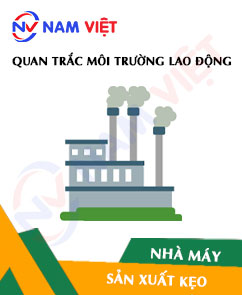
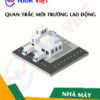
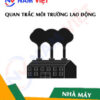
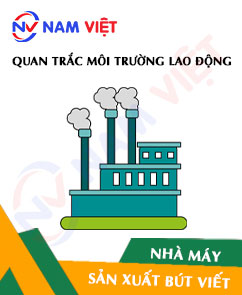

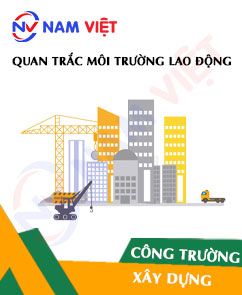


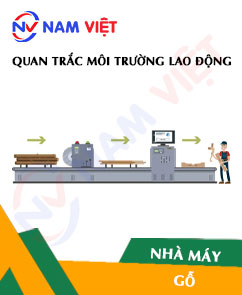


Review Occupational environment monitoring of a candy manufacturing factory
There are no reviews yet.